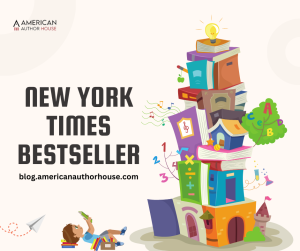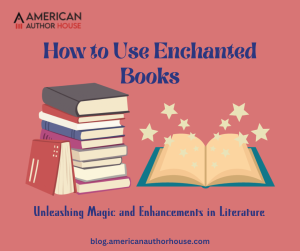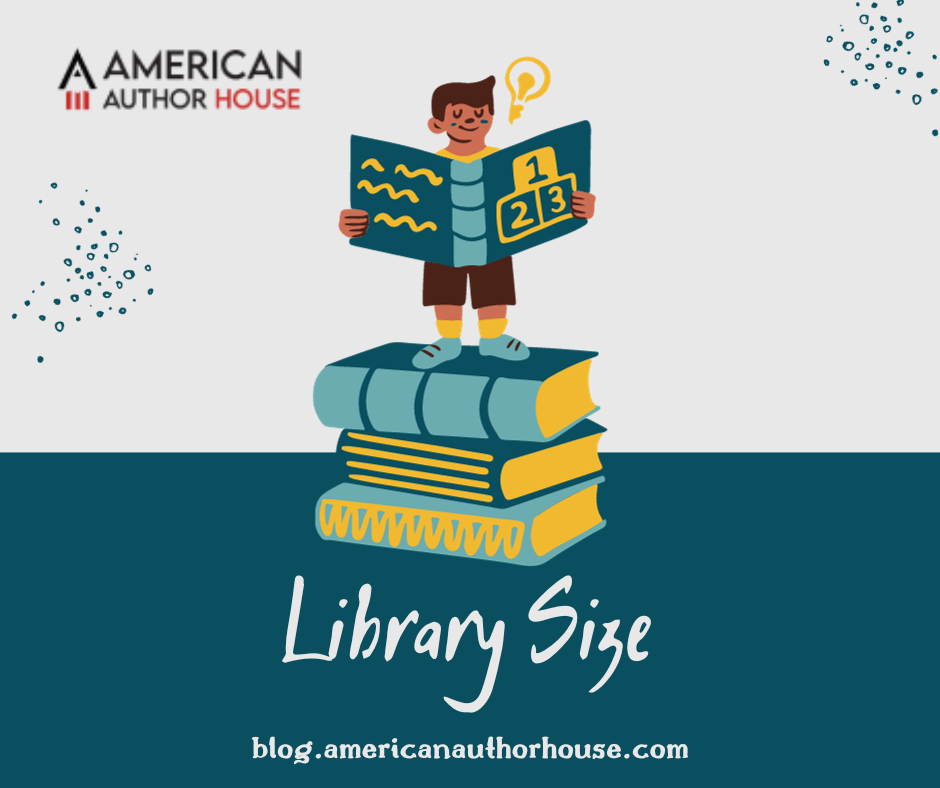
Books
When we think of a library, we usually think of a place with lots of books, quiet spots to read, and a treasure trove of knowledge. But have you ever wondered how many books you need to call something a library? In this article, we’ll look at what makes a library a library, explore its history, and see how technology has changed it. Plus, we’ll figure out how many books it takes to turn a collection into a real library.
What Constitutes a Library?
Libraries, which used to be places with just books, have changed a lot. Now, they have all kinds of stuff like digital stuff, videos, and even places to hang out. They help people learn, keep culture alive, and ensure everyone can use them. Even though they’ve changed, they still do what they’ve always done: help people learn and find information.
The Historical Perspective
Throughout history, libraries have played a significant role in preserving and spreading knowledge, but their nature and accessibility have evolved considerably. Here, we dig deeper into the historical perspective on libraries to gain a better understanding of their transformation from exclusive repositories of knowledge into the open and inclusive institutions we know today.
Libraries as Exclusive Treasures of Knowledge

In ancient times, libraries were indeed exclusive treasures of knowledge. The Library of Alexandria in Egypt, founded in the 3rd century BCE, is one of the most iconic examples. It was celebrated for its extensive collection of scrolls, and scholars from all over the known world flocked to study within its holy walls.
Limited Accessibility and Restricted Collections
Libraries of ancient times were characterized by limited accessibility. The general public had little to no access to these sources of knowledge. The collections themselves were relatively small compared to modern standards, partly due to the labour-intensive process of creating and copying manuscripts or scrolls by hand. The information was often kept under tight control, with the ruling authorities or religious institutions having a significant say in what was stored within the library’s walls.
Preservation of Knowledge
Despite their exclusivity, ancient libraries served as crucial hubs for the preservation and transmission of knowledge. Monks in medieval European monasteries also played a vital role in preserving classical texts during the tumultuous Middle Ages. The knowledge safeguarded in these libraries laid the foundation for future generations of scholars and thinkers.
The Modern Role of Libraries
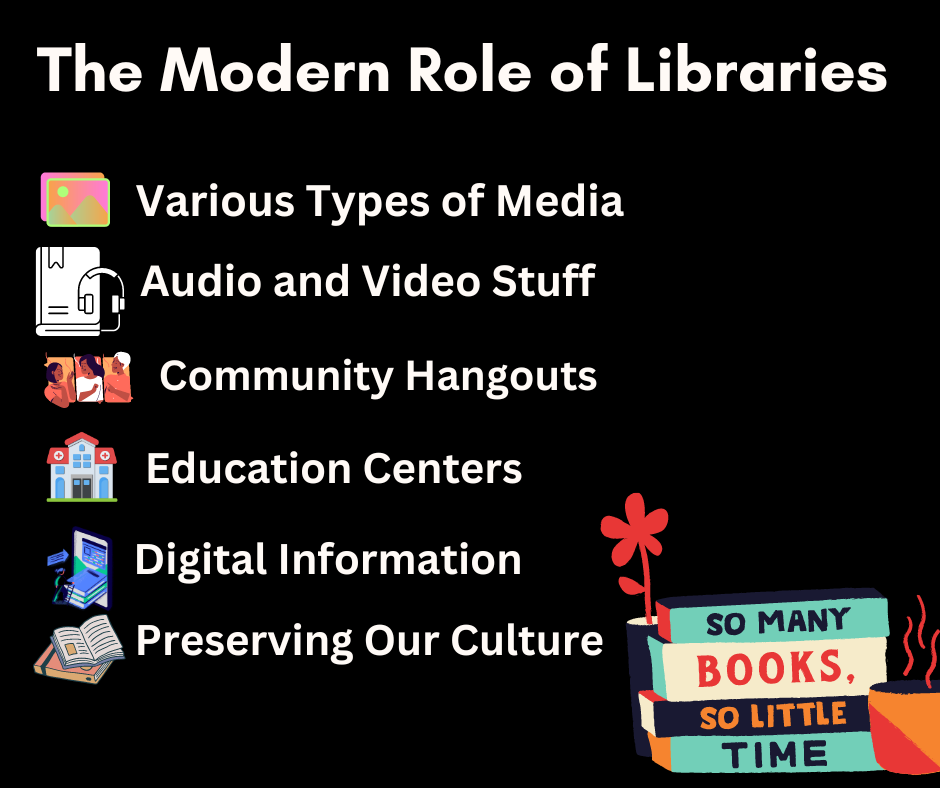
Today, libraries have changed greatly from the old image of just being places for physical books. They’ve become more than that, serving as important community centers for information and education. Here’s how they’ve evolved:
Various Types of Media
Libraries aren’t limited to just books anymore. They offer various materials like digital resources, e-books, audiobooks, magazines, and journals. You can even find e-books; like books you can read on your devices.
Audio and Video Stuff
Libraries also have things like DVDs, streaming services, and multimedia collections. They let you access movies, music, and other fun stuff. Plus, they can help you learn with educational videos and content.
Community Hangouts
Nowadays, libraries are like lively meeting places for the community. They host events, workshops, and talks, bringing people together to learn and collaborate. Many libraries even have rooms and technology for group activities and learning.
Education Centers
Libraries are important for learning. They have resources for students, teachers, and anyone who wants to keep learning. From helping kids with their homework to preparing adults for exams, libraries offer support. They also have online courses, language learning, and skill development programs for all ages.
Digital Information
Libraries are about digital resources like databases, research materials, and archives. They help students, professionals, and lifelong learners find reliable information for research and learning.
Preserving Our Culture
Libraries are like protectors of our history and culture. They keep special collections, old documents, and rare manuscripts to ensure we remember where we came from.
For Everyone
Libraries want to help everyone in the community, including people with disabilities. They offer special technology and Braille materials to ensure everyone can use their resources and services.
What Are the Different Sizes of a Library?
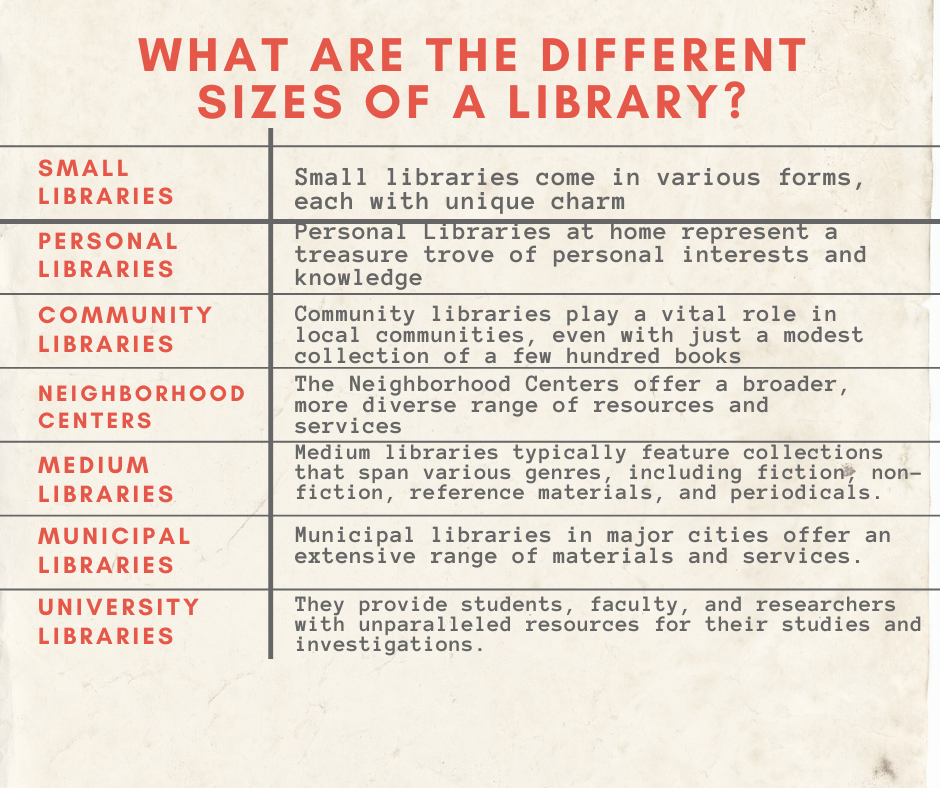
Following are the sizes of a library
Small Libraries
Small libraries come in various forms, each with unique charm and significance. They may not have the immense scale of larger institutions, but they play crucial roles in their own right.
Personal Libraries
Small collections of books at home represent a treasure trove of personal interests and knowledge. While they may consist of just a few shelves of books, these libraries are highly individualized. They mirror the owner’s tastes, passions, and intellectual journey.
Community Libraries
Small community libraries play a vital role in local communities, even with just a modest collection of a few hundred books. These libraries serve as accessible hubs of knowledge and entertainment for residents, bridging gaps in access to information. They provide a space where community members can gather, read, and learn.
The Neighborhood Centers
The Neighborhood Centers offer a broader, more diverse range of resources and services. While not as vast as municipal or university libraries, these libraries are essential for the communities they serve.
Medium libraries
Medium libraries typically feature collections that span various genres, including fiction, non-fiction, reference materials, and periodicals. They cater to a more substantial audience, encompassing avid readers, students, researchers, and community members seeking a quiet space for work or study. These libraries may also include multimedia resources like DVDs, CDs, and digital materials, catering to a more contemporary audience’s needs.
Municipal libraries
Municipal libraries in major cities offer an extensive range of materials and services. They serve as cultural hubs, housing collections that span all areas of human knowledge and creativity. Patrons can access books, digital resources, special collections, archives, and multimedia materials. These libraries often host lectures, exhibitions, and cultural events, contributing to their cities’ intellectual and artistic vibrancy.
University Libraries
University libraries are integral to the academic world. They provide students, faculty, and researchers with unparalleled resources for their studies and investigations. These libraries house vast academic collections, including rare manuscripts, academic journals, and specialized research materials. In addition, they offer dedicated study spaces, reference services, and support for scholarly endeavors. University libraries are learning centers and hubs for innovation and intellectual discovery.
The Digital Revolution’s Impact on Libraries
The Digital Revolution, driven by digital technology, has profoundly changed how libraries work. It affects how we find, keep, and share knowledge. E-books are becoming more common through platforms like American Author House, giving readers more choices.
E-Libraries: E-Books and Online Resources
One major change is the rise of e-libraries. They’ve transformed how we interact with books. With e-books and online resources, you don’t have to visit a physical library. You can access various literary works online, from home, or anywhere.
E-libraries have advantages
- E-books and online resources are available 24/7, so you can access them anytime, anywhere, making learning and research more flexible.
- E-books offer the convenience of being stored on various devices such as e-readers, tablets, or smartphones, allowing individuals to carry an entire library. As a result, they do not affect the physical size of a library.
- Digital books are easy to search. You can find specific content quickly with keyword searches and hyperlinked references.
- E-books often let you change font size and background color to match your preferences, making reading more user-friendly.
- E-books reduce the need for paper and transportation, which is better for the environment.
How Many Books Define a Library?
The ALA (American Library Association) doesn’t specify how many books a library must have. Some experts think a library should have at least 500 books to be a “real” library. But, the actual number can change based on what the library is for and who it serves.
A library should have materials for people from different cultures, languages, and interests. It should make everyone feel at home, no matter who they are. This might mean having books in different languages for all ages and covering many topics.
A top-notch library also thinks about what its community needs and likes. It might offer more than just books, like digital stuff, internet access, and spaces for meetings, events, and learning. A good library changes and grows to match the needs of its users. It keeps up with new technology and adds new things to its collection to stay relevant.
So, the number of books in a library is just one part of the story. What counts is how diverse and inclusive its collection is and how well it connects with and serves the community. Libraries are about learning, exploring, and bringing people together, and that’s way more important than counting books.
Do Book Publishing Services Prefer Amazon To Traditional Services?
Book publishing services vary in their preferences. While Amazon has gained popularity for self-publishing, traditional publishing services still play a significant role for many authors, offering the advantage of established distribution and marketing networks.
What Are The Best Fantasy Books Available In Popular Libraries?
The availability of best fantasy books in libraries can vary, but popular choices often include classics like “The Lord of the Rings” by J.R.R. Tolkien and modern series like “A Song of Ice and Fire” by George R.R. Martin. Local libraries may also have their curated lists of popular fantasy books.
Do Libraries Offer Books by Authors Similar To Colleen Hoover?
Libraries often offer a wide range of contemporary romance authors, including those with writing styles similar to Colleen Hoover. You can inquire at your local library or use their online catalog to find books by authors who share similar themes and writing styles.
How to Become an eBook Writer?
To become an eBook writer, you can start by improving your writing skills, selecting a niche, researching your target audience, planning your eBook, writing it, editing, designing a cover, publishing on platforms like Amazon KDP, and marketing your eBook effectively. Collecting reviews and feedback is also important for your success.
Does The Size of a Library Matter?
In terms of physical space and the number of books it contains, the size of a library can matter to some extent, but it’s not the only factor that determines the value or importance of a library.
Key Aspect of Libraries and Profound Details
| Aspect of Libraries | Details | Evolution Over Time |
|---|---|---|
| Definition & Purpose | Places for books, learning, and cultural preservation | From book repositories to diverse learning centers |
| Historical Perspective | Ancient treasure troves to modern inclusive spaces | From exclusive to accessible for all |
| Types of Media | Books, digital resources, audio/video | Expansion beyond traditional books |
| Community Role | Education, culture, meetings, events | Evolved into community hubs |
| Size & Composition | Varies from small to large, personal to university | Grown in diversity and accessibility |
| Digital Revolution Impact | E-libraries, e-books, online resources | Shifted access and expanded reach |
| Significance | Not just about book count but diversity & service | Focus on inclusivity, diversity, and accessibility |
Conclusion
The essence of a library has evolved with time. It’s not just about the sizes of a library but about inclusivity, diversity, and accessibility. Libraries have embraced the digital age, becoming digital hubs while preserving cultural significance.

